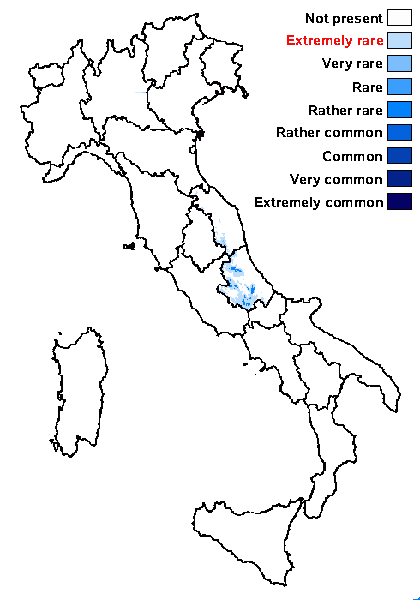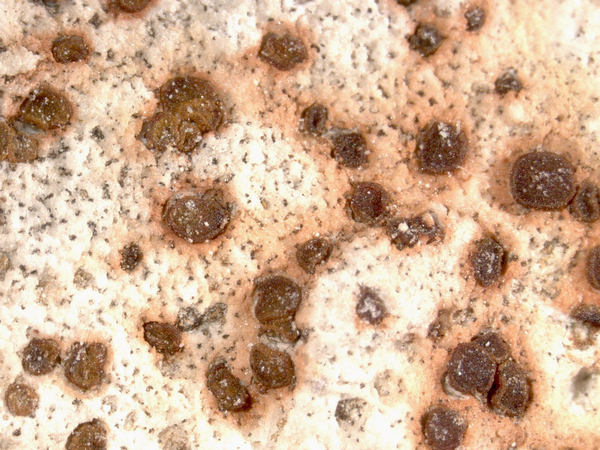Caloplaca keissleri (Servít) Poelt
Mitt. bot. Staatssamml. München 5: 261, 1964. Basionym: Blastenia keissleri Servít - Hedwigia 74: 149, fig. 4, 1934.
Synonyms: Caloplaca nubigena var. keissleri (Servít) Clauzade & Cl. Roux
Distribution: C - Marc (Nimis & Tretiach 1999), Abr (Nimis & Tretiach 1999, Gheza & al. 2021).
Description: Thallus crustose, endosubstratic and usually evident only as a faint discolouration of the rock, rarely very thinly episubstratic and small-granulose, forming 1-2 cm wide, more or less orbicular, often confluent patches. Apothecia biatorine, 0.2-0.3(-0.5) mm across, completely immersed in shallow pits of the rock, with a dark orange, usually flat to slightly convex disc, and a thin, flexuose, slightly paler proper margin, without a thalline margin. Proper exciple thin, weakly developed, paraplectenchymatous, the cell lumina large; epithecium orange-brown, K+ purple-red; hymenium colourless, 60-80 µm high; paraphyses simple or sparingly branched, the apical cells slightly swollen; hypothecium colourless, paraplectenchymatous, the cells with large lumina. Asci 8-spored, clavate, functionally unitunicate, apically thickened with a broad internal beak, the inner part of apex and external cap I+ blue, Teloschistes-type. Ascospores 2-celled, polarilocular, hyaline, ellipsoid, 11-13.5 x 5-6(-8) µm, the equatorial thickening (“septum”) 3-4(-5) µm. Photobiont chlorococcoid. Spot tests: thallus K-, C-, KC-, P-; apothecia K+ purple-red. Chemistry: apothecia with unidentified anthraquinones.Note: a non-lichenicolous taxon with an endolithic thallus indicated by usually whitish patches, and sunken orange apothecia with slightly concave discs and thin parathecial margin (overall aspect recalling somewhat Protoblastenia incrustans). Often considered just as a form of C. nubigena poor in anthraquinones, but according to Wilk (2012) also differing in the paraplectenchymatous proper exciple and hypothecium. Molecular data are needed to clarify generic position and conspecificity of the two taxa,
Growth form: Crustose endolithic
Substrata: rocks
Photobiont: green algae other than Trentepohlia
Reproductive strategy: mainly sexual
Commonnes-rarity: (info)
Alpine belt: rather rare
Subalpine belt: rather rare
Oromediterranean belt: very rare
Montane belt: extremely rare
Submediterranean belt: absent
Padanian area: absent
Humid submediterranean belt: absent
Humid mediterranean belt: absent
Dry mediterranean belt: absent

Predictive model
Herbarium samples
Growth form: Crustose endolithic
Substrata: rocks
Photobiont: green algae other than Trentepohlia
Reproductive strategy: mainly sexual
Commonnes-rarity: (info)
Alpine belt: rather rare
Subalpine belt: rather rare
Oromediterranean belt: very rare
Montane belt: extremely rare
Submediterranean belt: absent
Padanian area: absent
Humid submediterranean belt: absent
Humid mediterranean belt: absent
Dry mediterranean belt: absent

Predictive model
| Herbarium samples |
 Index Fungorum
Index Fungorum
 GBIF
GBIF




